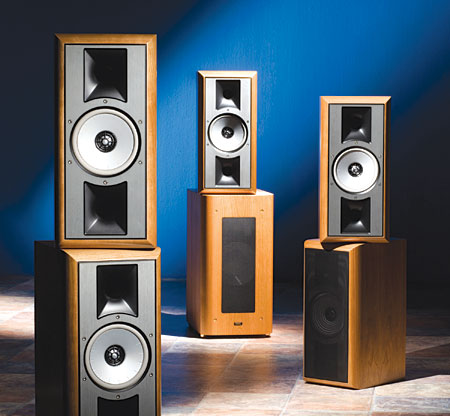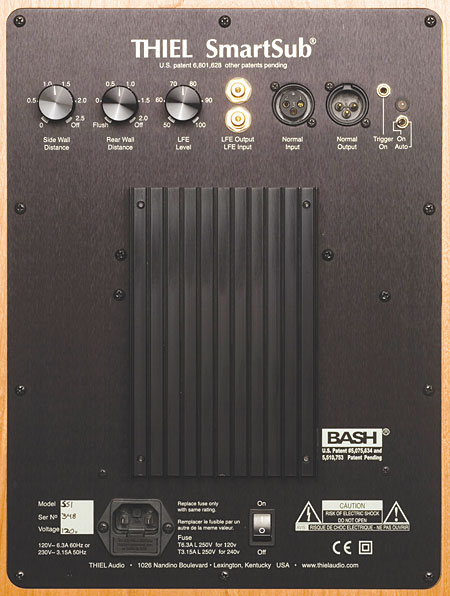Thiel SCS4 Speaker System
Jim Thiel must be a magician. At least that’s what I thought when I first heard his newest speaker, the SCS4. I was listening to an a cappella band, and the guys were all there—not just the voices, but I felt like the Persuasions were in the room with me. The sound was so utterly natural; it was as if the speakers weren’t doing anything.

A Disappearing Act
Instead of the usual assortment of tweeter, midrange, and/or woofers stacked up on the front baffle, the SCS4 appears to have just one driver. Look a little closer, and you’ll see a 1-inch aluminum-dome tweeter sitting in the apex of an aluminum-coned 6.5-inch woofer. Thus, it’s technically a two-way, coaxial design. The unusual arrangement ensures that every listener seated on your couch hears the sound from each speaker’s tweeter and woofer at exactly the same time. This coaxial design performs equally well in a vertical or horizontal orientation, and you can place it on a shelf or speaker stand. My review system included five SCS4s, and the sonic advantages of running identical speakers in the front, center, and surround channels were evident in the system’s seamless soundstaging and razor-sharp imaging. That said, if you prefer in-wall or on-ceiling surround speakers, Thiel’s PowerPoint 1.2 and HigherPlane will be up to the job; they employ driver technologies very similar to the SCS4’s. The Thiel sound runs throughout the line.
Talk about magic. The SCS4 is a good deal less expensive than the model it replaces, the SCS3, and the new one is built to an even higher standard. The tweeter is nearly identical to the one used in Thiel’s flagship speaker, the CS3.7, and the SCS4’s cabinet now uses a cast-aluminum baffle to provide much greater structural rigidity, a more secure platform for driver mounting, and a reduction of cabinet resonances. The 1-inch-thick, medium-density fiberboard parts of the cabinet are reinforced with thick bracing. The satin-finished, real-wood cherry veneers on my samples were absolutely stunning, and the heavily gold-plated speaker binding posts would qualify as audio jewelry. (Yes, I know I’m a geek.)
The elegantly proportioned SS1 SmartSub is one of the prettier subwoofers I’ve seen. Its 10-inch, aluminum-coned woofer peeks through a non-removable, perforated metal grille. Designed by Jim Thiel, the driver features a heavy cast-aluminum frame and a special short-coil/long-gap motor system that keeps distortion low during high excursions of the cone. The SS1 won’t smack you with the sort of room-shaking ka-boom you’d get with some cube powerhouses, but the SS1’s included amplifier is rated at 500 watts. While most subwoofers are pretty dumb—they don’t know or care where they are in your room—Thiel’s SmartSub sports controls that let you input its distance from the side and rear walls. Armed with that knowledge, the SmartSub can tailor the bass in an effort to generate flatter and smoother in-room response. That’s brilliant.

You can hook up the SS1 directly with its RCA/LFE input, or via XLR to the Thiel PX05 passive subwoofer crossover ($500). The PX05’s snazzy brushed-aluminum chassis certainly looks high end, and its backside is outfitted with five sets of gold-plated speaker binding posts and an XLR connector that feeds the SS1. Each PX05 is built to work with specific Thiel speakers and sub models. Therefore, you can mix floorstanders, SCS4s, and in-ceiling models and still get an integrated speaker/subwoofer system. With the PX05 hooked up, I ran the SCS4s as large speakers over my Sunfire Theater Grand III pre/pro. While the PX05 passive crossover didn’t remove any of the bass demands from the main speakers, it effectively turned the SCS4/SS1 into a full-range speaker system. They performed so well that it was easy to forget that the SCS4s were running full range and the SS1 was supplying additional bass.
The “Aha” Moments
A speaker’s ability to startle, to deliver what I call the “aha” moments that stop me in my tracks, are what separate the merely good from great speakers for me. Those moments came fast and furious when I revved up the simulated earthquake scene on the Ocean’s Thirteen DVD. The SS1’s room-shaking rumbles perfectly matched the onscreen casino’s shake, rattle, and roll. Ocean’s Thirteen feels like a tired retread of the heist flick, but that one scene’s far-fetched earthquake diversion left no doubt about the SS1’s deep penetration into the lowest octaves. The five SCS4s conjured the casino’s immensity and the panicked patrons’ gasps of fear. The Thiel ensemble can clearly muster the gravitas of a larger system. Of course, if your home theater is bigger than average, I’d recommend that you add a second SS1 and run them in stereo. Then again, moving up to Thiel’s larger SS2 ($4,900) might really be something to consider. The SS3 ($6,900) and SS4 ($8,900) subs are a little pricey for a system built around SCS4s, but hey, I can dream.
Live Free or Die Hard totally knocked me out. The DVD is definitely an aerobic workout for a home theater system, especially when John McClane (Bruce Willis) uses his New York City police car to knock a bad guy’s helicopter out of the sky. Asked why he trashed the cop car, McClane mutters, “I ran out of bullets.” He’s still funny after all these years. When the copter tumbles and finally crashes and burns, you can almost feel the heat. An “aha” moment for sure.
The acoustic tunes on the Led Zeppelin DVD two-disc set sounded incredibly vivid. Jimmy Page’s strumming on “That’s the Way,” the immediacy of Robert Plant’s vocals, and the hushed presence of the crowd at this 1975 concert were all top notch. I’ve played these DVDs through what seems like a gazillion speakers, and I wasn’t all that impressed with their sound. But the Thiels had me rethinking that opinion. On “Bron Yr Aur Stomp,” the audience clapping erupted, flawlessly centered between the front and surround speakers.
The multichannel SACD and DVD-Audio discs were even better. The sonic advantages of having five full-range, point-source speakers aren’t subtle. After I carefully positioned all of them exactly 9 feet from the sweet spot, the continuousness of the surround field was better than I’ve ever before heard at home. Roxy Music’s Avalon SACD sounded huge, with imaging behind the actual planes of the speakers themselves. The SCS4s effortlessly revealed subtle details in Bryan Ferry’s vocals. Great singers really shined over these speakers, so I went for the best—the Sinatra at the Sands DVD-Audio. It projected a sharply focused holographic environment with Old Blue Eyes holding court in the legendary Las Vegas venue with the Count Basie Orchestra. Wow!
Yeah, I know these two high-resolution audio formats are fast fading, so I’m hoping these titles will reappear on Blu-ray and HD DVD. And if they do, Thiel will be ready with the SCS4. The speaker is capable of producing spacious soundstaging with superb depth, width, and height independent of the speakers themselves. The SS1 has been in the line now for a few years, but it’s fully the equal of the SCS4’s technological achievements. Jim Thiel takes his time nurturing his designs, which can take years to come to market. But boy oh boy, they’re always worth the wait.
Highlights
Thiel’s radical, yet altogether elegant design yields extraordinary sound quality
Stunning furniture-grade cabinetry




























































